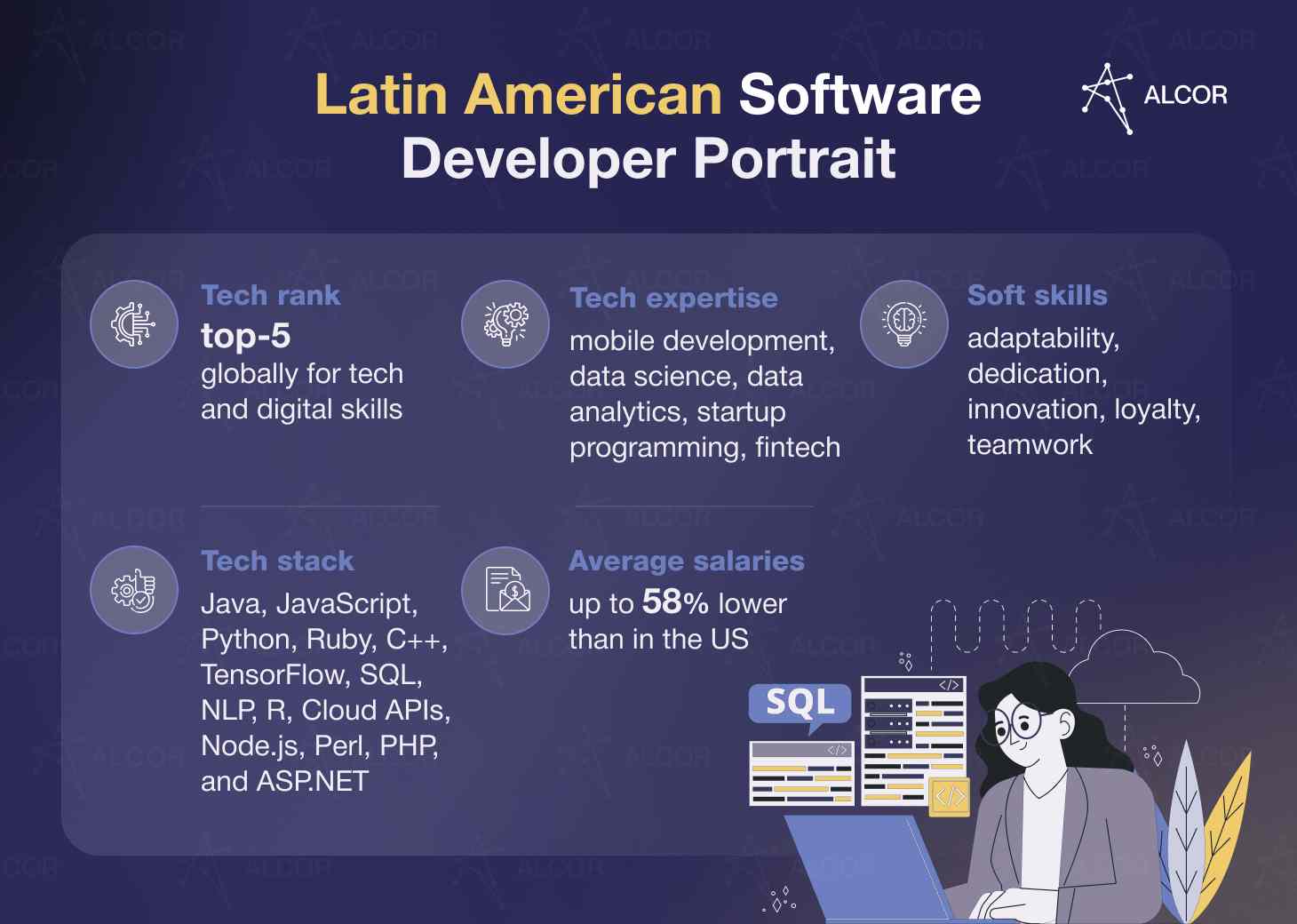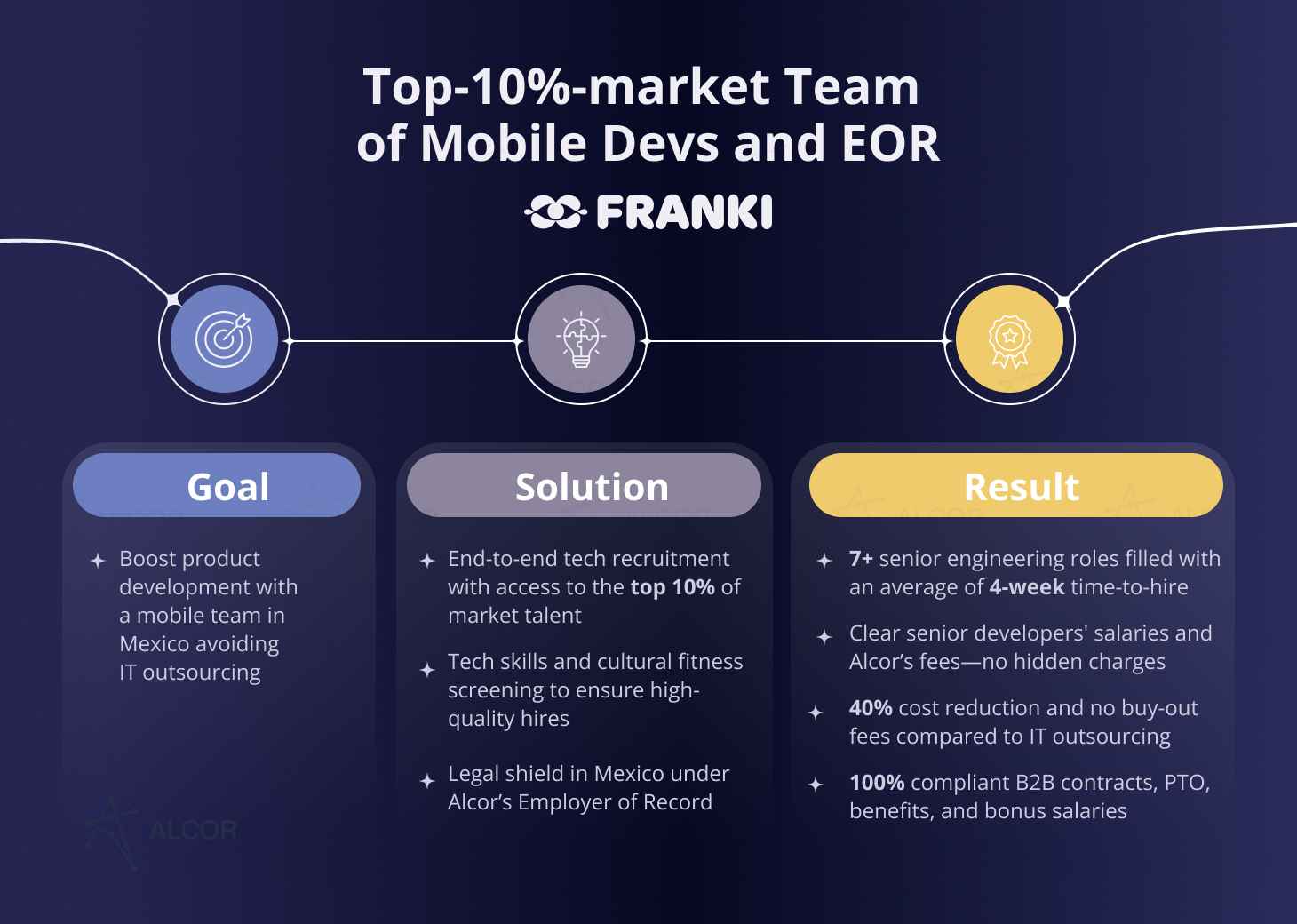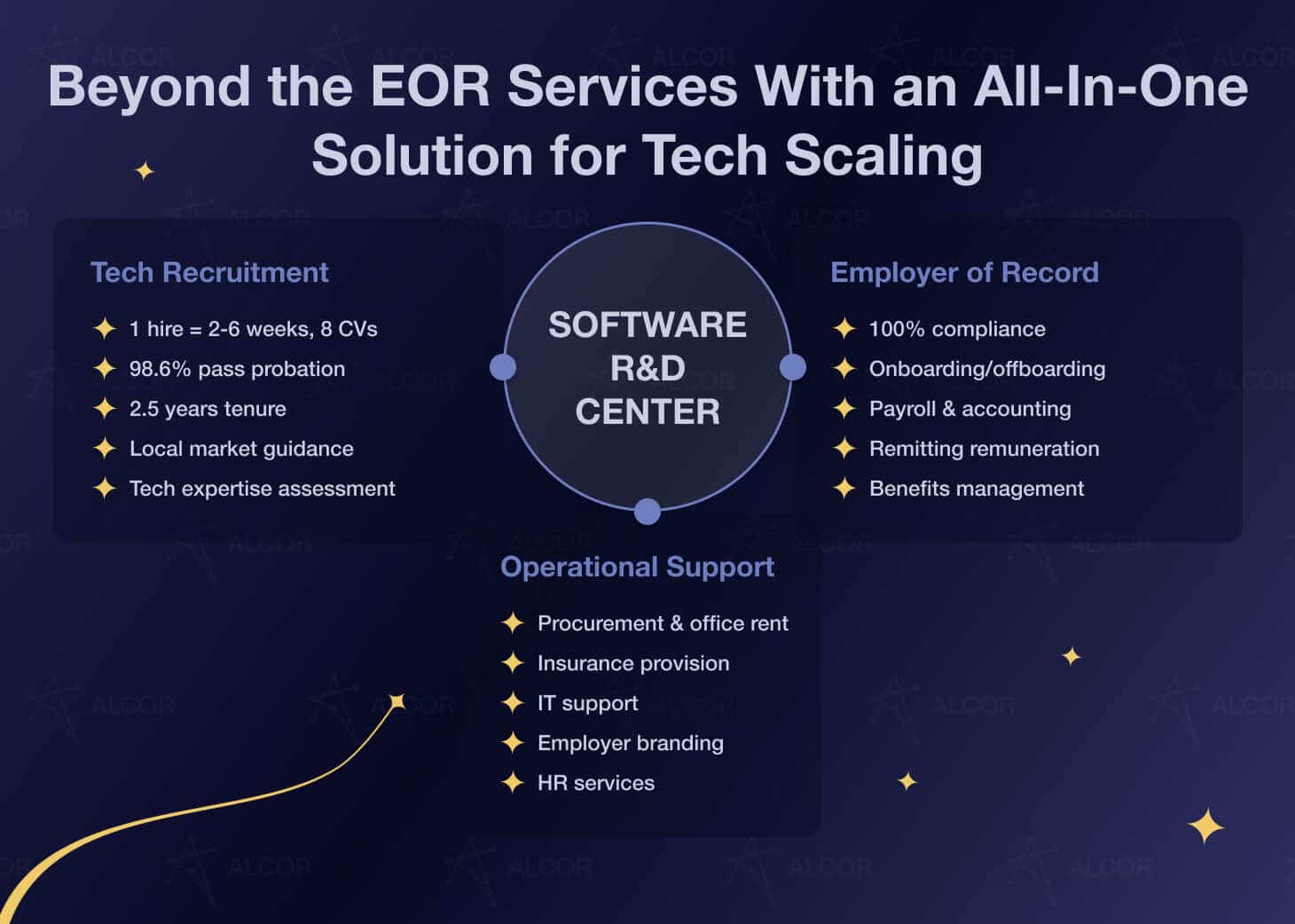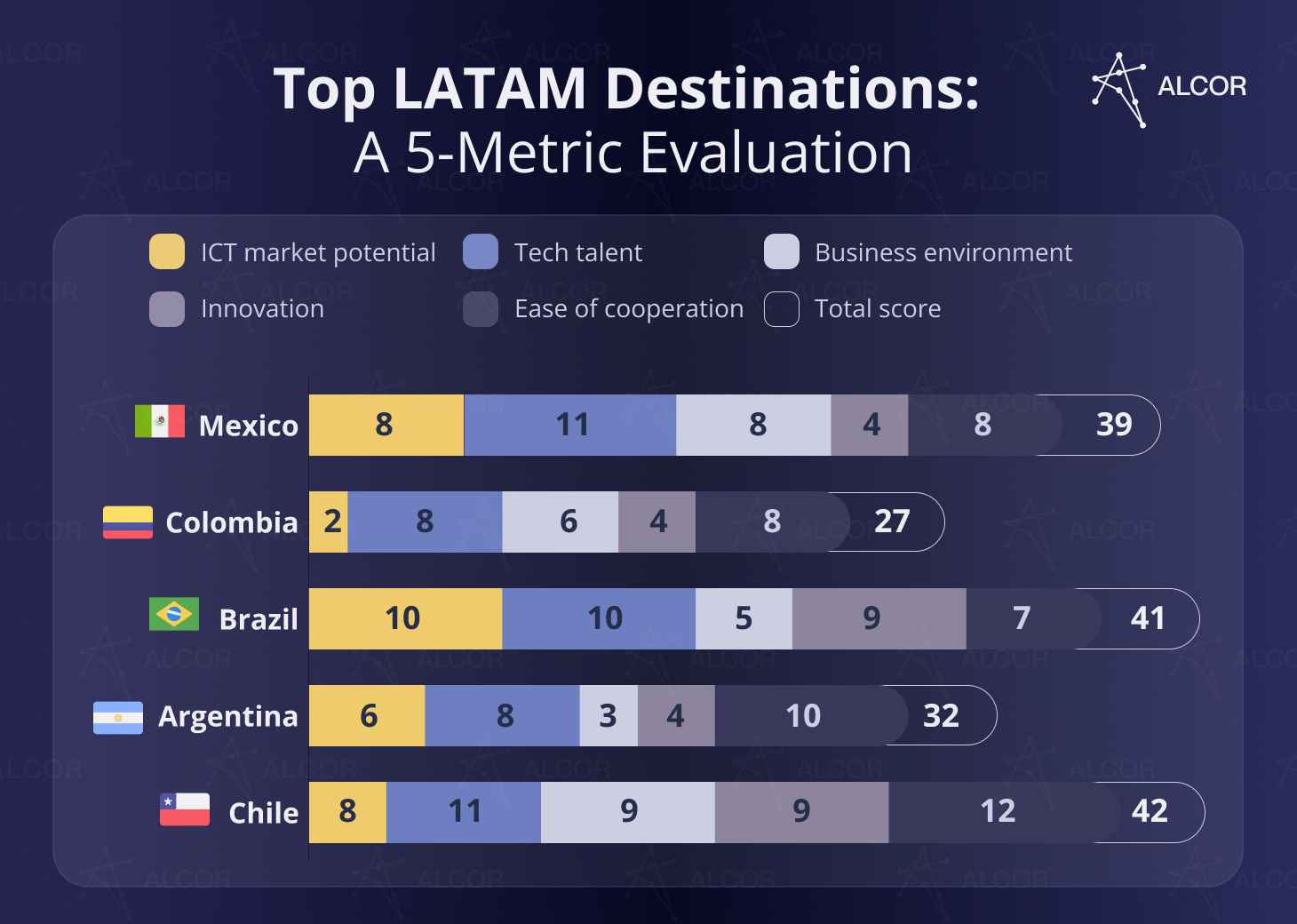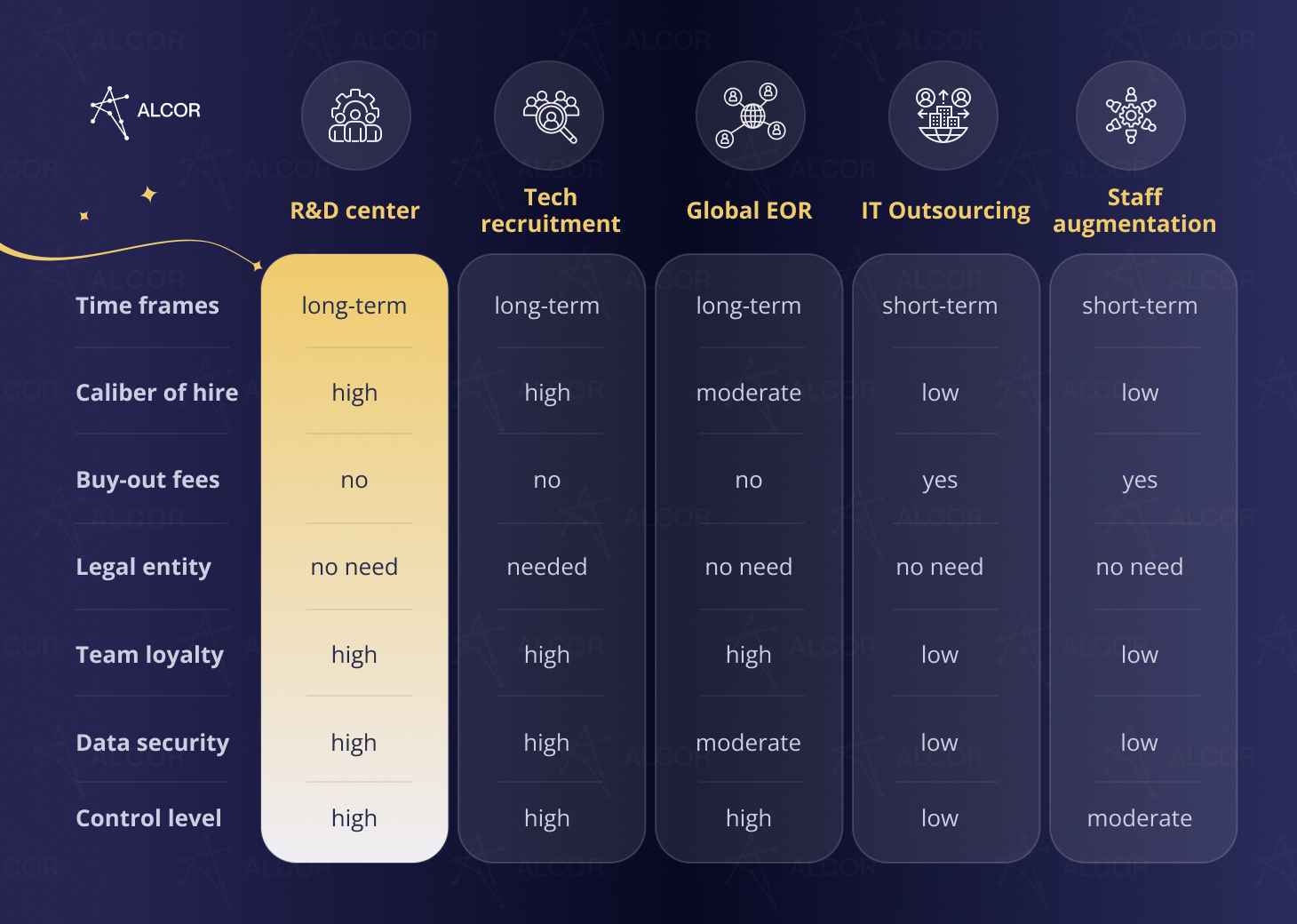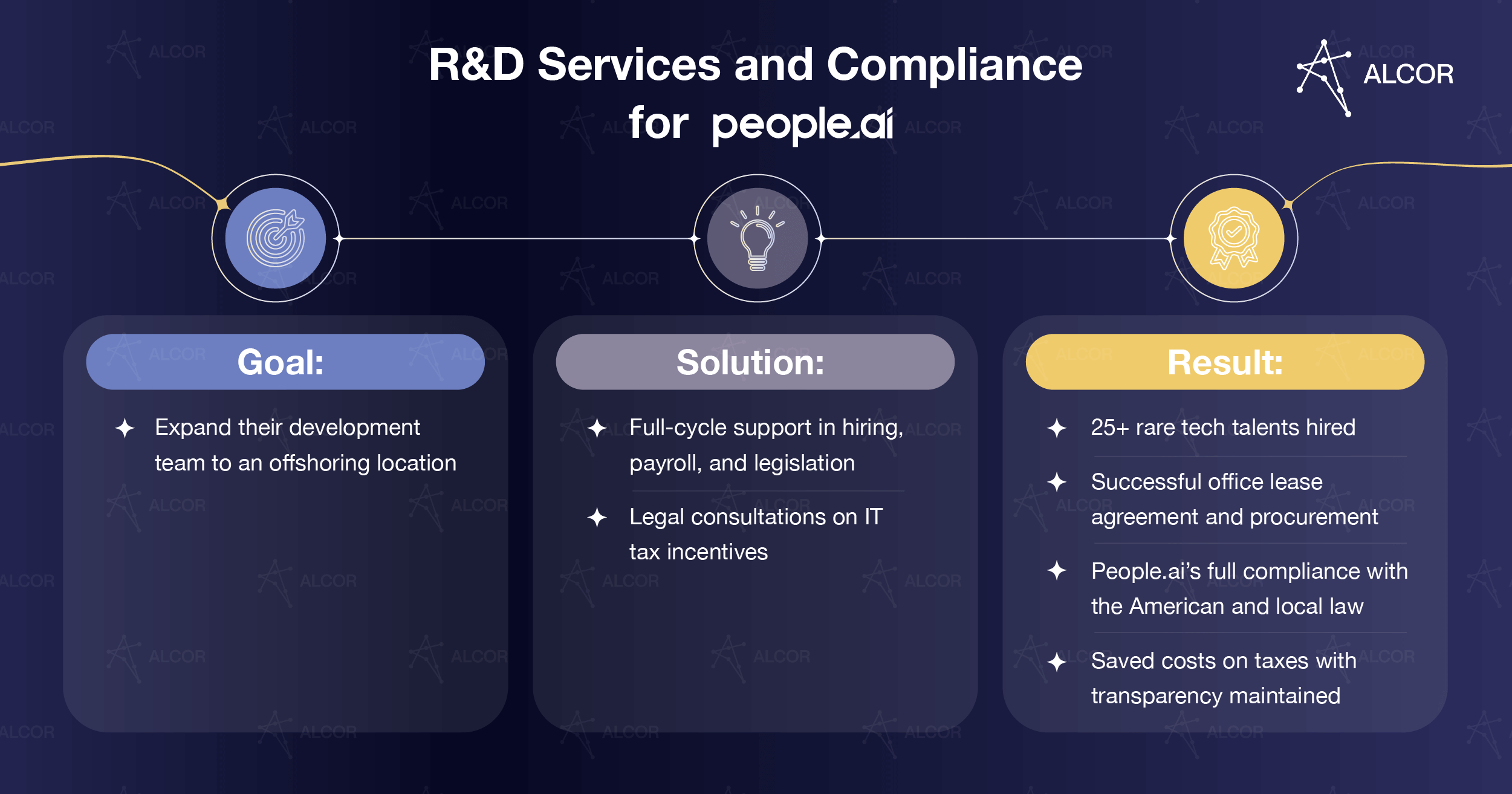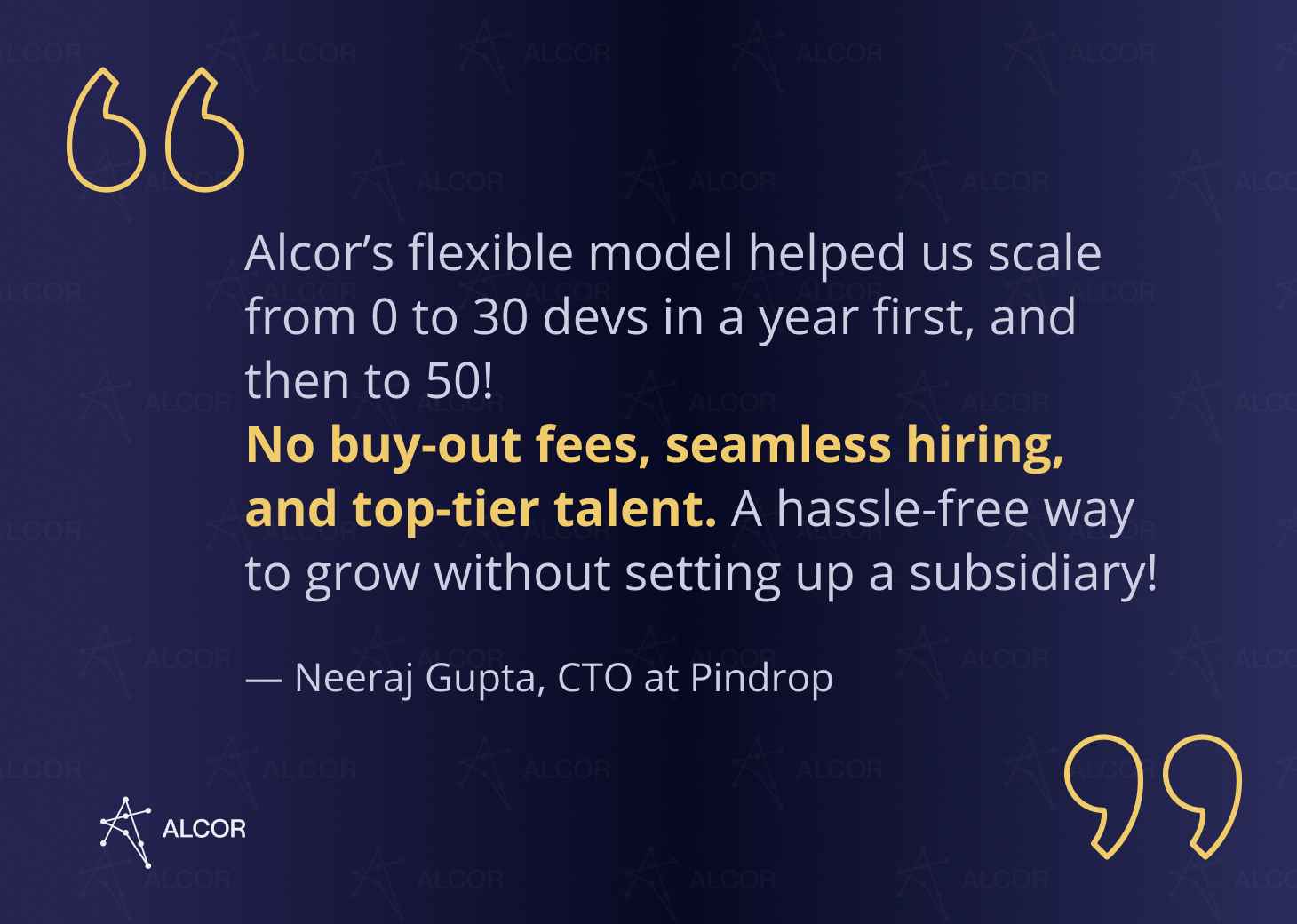Thinking of hiring Latin American developers? With a 2M+ talent pool, cost-efficiency, and geographic proximity, it’s a great place to scale your software product. In fact, the region’s software market revenue is set to grow to $20.2 billion by 2029. But where in LATAM and how should you hire these developers? Let’s find out!
I’m David Gomez, Alcor’s Lead of the IT Recruitment department in LATAM. With our software R&D center solution, tech companies scale their teams from 0 to 100 elite software engineers in a year—no legal entity needed.
By the end of this article, you’ll have a holistic picture of Latin America as a region for software product development and its tech talent pool. Plus, you’ll be able to pick the most optimal location and ideal cooperation model for your tech business.
Key Takeaways:
- Latin America is becoming a go-to nearshoring region for US companies, with its software market set to gain $14 billion in service experts in the midterm.
- LATAM developers excel at mobile development, data science, Java, and Python, with strong dedication, collaboration, and proactiveness.
- The annual developer employment cost in LATAM is about 56% lower than in the US.
- Mexico demonstrates the best combination of quantity, quality, and cost of tech talent, coupled with a business-friendly ecosystem.
- Labor laws, taxes, and cybersecurity are the main outsourcing challenges in LATAM. Partnership with Alcor, a local R&D center service provider, is the most effective way to ensure hassle-free expansion.
Is Outsourcing to LATAM a Trend of 2025?
Looks like it, as nearshore outsourcing is expected to add an annual $14 billion in service exports in Latin America and the Caribbean in the medium term. Not only does the region boast skilled tech talent, but it also offers a vigorous software engineering landscape. Just see the figures:
- The South American software market is going to reach $16.3 billion in 2025 and grow by an additional $4 billion in the next 4 years, showing positive revenue dynamics.
- As for the revenue in the Latin American outsourcing market, it will surpass $27 billion by 2029.
- $184.3 billion of FDI entered Latin America and the Caribbean in 2023, proving foreign investors’ trust in the local economy and industry potential.
- Fintech dominates Latin America with 3,069 companies—a jaw-dropping 340% growth in just six years. Brazil, Mexico, and Colombia rule the region, accounting for a total of 57% of fintechs.
- LATAM houses over 9,000 startups, including 60 unicorns, which attracted $3.9 billion in VC investment in 2024. São Paulo, Mexico City, and Buenos Aires together received over $2 billion, while fintech led the way with $2.4 billion in investment.
- E-commerce unicorns have secured the top spot: Kavak from Mexico and Rappi from Colombia are the leading unicorns in LATAM.
- The region is famous for its high digital transformation potential and rapidly adopting software development trends like cloud computing, AI, and IoT solutions. The stand-out LATAM countries in this regard are Mexico, Colombia, and Brazil.
Why Tech Companies Hire Latin American Developers?
#1 Abundant talent pool
Latin America has amassed a 2+ million pool of top talent. Mexico comes first with over 800K tech experts, followed by Brazil and Colombia with 540K and 165K, Argentina with 140K, and Chile with 66K. Each year, 437 LATAM universities bring up over 220K STEM graduates, fostering the expertise of the local talent pool with diverse skill sets. For tech companies that embrace nearshoring, this means faster filling of in-demand roles and reduced time-to-hire of rare and niche developers.
#2 Top tech expertise
Speaking of skills, Latin America boasts some of the brightest software engineers, with Brazil, Mexico, and Chile topping the Coursera ranking for the best technology and data science expertise. It’s no surprise, as 17 Best Global Universities for Computer Science in LATAM and local initiatives like Mexico’s Codeacademy, Argentina’s 4.0 Program, and Chile’s Digital 2035 plan increase the tech-savviness of the local talent. Software developers in LATAM possess an impressive tech stack that I’ll discuss in the next chapter. Stay tuned!
#3 Double the devs, same cost
What if I told you that you can get high-quality software development at a 50% lower price? That’s possible with LATAM developers! Just compare annual salaries: a senior DevOps engineer in the US earns up to $138K, while the same tech expert in Latin America makes an average of $63K-$72K a year. That’s a $60K+ saving per developer—enough to scale your team even further, invest in innovation, or enhance your software product!
#4 Seamless cooperation
Thanks to geographical proximity, the nearshore software development process is hassle-free. The time zone difference amounts to 1-4 hours at most, while California-based tech companies can enjoy real-time cooperation by expanding their software development to Tijuana, Mexico or choose to consider software devlopment services in Guadalajara. Result? Your team management will be a no-brainer.
To add to it, geographical closeness results in cultural affinity and similar working ethics, further enhanced by high levels of English proficiency, present in the skill set of Latin American best talent.
#5 Highly motivated talent
Did you know that the number of LATAM applicants for nearshore tech jobs increased by 370% during the last 4 years? Higher salaries, opportunities for career growth, and the possibility to work on hi-tech projects draw LATAM developers to North American tech companies like bees to honey. For you, as a tech executive, it’s a perfect chance to bridge talent gaps and build a highly motivated and dedicated tech team that will take your software development to the next level.
Latin American Developer Portrait
You’re probably wondering what it’s like to work with software developers from Latin America. Let’s dive into their hard & soft skills, plus cultural traits, and see what they can bring to the table.
Mexico
In comparison with other developers from Latin America, coders from Mexico can be described thus:
- Experts in mobile development & fintech, plus JavaScript, Java, Python, SQL, and C++;
- Leaders in tech and data science—#3 in LATAM;
- Prized for assertive and expressive communication, punctuality, and excellence-driven work ethic;
- Culturally famous for teamwork, collaboration, and continuous learning values.
Colombia
What about Colombia? Colombian developers are…
- Experts in startup programming, JavaScript, Python, Ruby, SQL, and HTML CSS;
- Leaders in JavaScript: Colombia has an entire hub with more than 3,000 members and regular JS-meetups in 8 cities;
- Prized for openness, superior time management skills, and adaptability;
- Culturally famous for valuing trust and close-knit teams and showing work initiative and dedication.
Chile
Chilean coders don’t lag behind as they are:
- Experts in data science, data analytics & statistical programming, as well as Java, Python, Node.js, Perl, PHP, and ASP.NET;
- Leaders in digital skills and #10 in LatAm for English skills;
- Prized for flexibility, thirst for challenge, and smooth communication;
- Culturally famous for modesty, solidarity, and loyalty.
Argentina
Tech specialists from Argentina close the list with the following key characteristics:
- Experts in database & mobile development, plus Python, TensorFlow, SQL, NLP, R, and Cloud APIs;
- Leaders in English proficiency in LATAM;
- Prized for autonomy, meticulousness to detail, and commitment to quality work;
- Culturally famous for innovation and creativity in their workplace environment.
Wondering which LATAM destination suits your business needs best? Keep reading to compare top locations with our tailored metrics!
Latin American vs US Developer Salary
Say you want to hire a software development team in Latin America, but which location is the most ideal cost-wise? Firstly, let’s take a quick look at senior developers’ wages.
| Technology | Senior Developer’s Gross Annual Income, USD | ||||
| USA | Mexico | Colombia | Chile | Argentina | |
| AI/ML Engineer | $132,000 | $61,000 | $60,000 | $62,000 | $57,500 |
| Coud Engineer | $174,000 | $68,500 | $54,000 | $62,500 | $68,500 |
| Blockchain Developer | $132,500 | $68,500 | $62,500 | $61,500 | $60,000 |
| Java Developer | $114,000 | $66,000 | $60,000 | $60,000 | $57,500 |
| Python Developer | $126,000 | $62,500 | $60,000 | $60,000 | $56,500 |
| C/C++ Develoepr | $114,000 | $66,000 | $57,500 | $54,000 | $54,000 |
| Mobile App Developer | $115,000 | $62,500 | $62,000 | $62,000 | $62,000 |
| Manual/Automation QA | $84,000 | $51,500 | $48,000 | $45,500 | $48,000 |
| UI/UX Developer | $102,000 | $60,000 | $57,500 | $57,000 | $54,000 |
| Product Manager | $120,000 | $51,500 | $51,000 | $51,000 | $50,500 |
As you can see, the average salary of a senior software developer in Latin America is about half of what you pay in the US. For instance, a sought-after AI or ML engineer will cost you only $57K in Argentina and $60K in Colombia. High-priced Cloud engineers, with a $174K price tag in the US, are only $68K in Mexico and Argentina. Building a mobile app? The LATAM software developers, highly skilled in iOS, Android, and Xamarin, charge only $62K per year.
Knowing the annual salary rates is only the tip of the iceberg. To calculate the total labor expenses in Latin America, you need to add
- employee benefits package, which typically includes health insurance, professional training, hardware, and corporate merchandise, totaling about $6,500 in LATAM and $15,500 in the US;
- recruitment fee, which is typically 20% of the gross annual salary for a senior developer in Latin America and 30% in the US.
Here is the comparison of the employment cost you need to hire LATAM developers vs American tech talent:
| Senior Position | Annual Developer Employment Cost, USD | ||||
| USA | LATAM | ||||
| AI/ML Engineer | $187,000 | $78,700 | |||
| Coud Engineer | $241,700 | $83,000 | |||
| Blockchain Developer | $187,500 | $82,200 | |||
| Java Developer | $163,700 | $80,000 | |||
| Python Developer | $179,300 | $78,200 | |||
| C/C++ Develoepr | $163,700 | $76,000 | |||
| Mobile App Developer | $165,700 | $81,400 | |||
| Manual/Automation QA | $124,700 | $54,300 | |||
| UI/UX Developer | $148,000 | $75,300 | |||
| Product Manager | $171,500 | $68,500 | |||
With the average total cost for a senior software developer in the US exceeding $173K a year, you can cut your labor expenses by about 56% with LATAM software developers.
Other essential expenses that you, as an employer, should take into account include taxes, social contributions, and additional payments required by local labor laws, such as a 13th-month salary in Colombia and Argentina, and an extra 15 days of wage per year in Mexico. Partnering with a local provider that offers Employer of Record in Latin America can take these calculations off your shoulders.
Challenges of Hiring LATAM Developers
#1 Data leakage
Latin America has proven vulnerable to cybersecurity attacks due to the insufficient legal enforcement of corresponding measures. This poses a threat to your product’s core intellectual property. While Argentina, Brazil, Mexico, and Chile are adopting frameworks to guarantee data protection, it is better to stay vigilant if you hire developers in Latin America.
Ensure database security and encryption, and choose a cooperation model that allows you to retain the IP rights within the company. For example, traditional IT outsourcing or IT staffing services in Latin America involve an external vendor that leases programmers to you. The likelihood of your sensitive data being exposed is significantly higher.
Pro tip: Consider alternative models, such as a software R&D center in LATAM, which allows you to hire coders directly onto your team, keeping your sensitive data in-house.
#2 Intricate Taxes
Latin American taxation is generally appealing to US technology companies. In Colombia, for example, tech businesses investing in R&D can receive a 30% tax credit for investing in innovation, while in Mexico, hi-tech and R&D companies get immediate tax deductions of 56% to 89% on fixed asset investments.
At the same time, if you want to hire LATAM developers, you need to consider the tax difference between the two major employment contracts, such as traditional and B2B. How does that work? Take Mexican business taxes. For traditionally employed software engineers, the Mexican government requires a 25% personal income tax plus a 30% company tax. When cooperating under the B2B model, there is only a PIT of 1% to 2.5%, which is covered by the contractor.
Pro tip: Look for providers with legal entities across LATAM to flexibly hire nearshore developers on an FTE or B2B basis—tailored to your needs. For instance, Alcor can employ programmers on FTE in Mexico and Colombia while we hire contractors on B2B across the region.
#3 Complex Labor Laws
As labor landscapes differ across countries, you will inevitably stumble across differences in PTO, working hours, national holidays, etc. Before cooperating with LATAM software developers, study labor laws and weigh up all the risks. For instance:
- Mexican employees should work no more than 48 hours per week, have 7 paid public holidays, and are entitled to 10% of their annual taxable profits of the company (the pay distribution is based on the number of days worked and the employee’s salary).
- Colombian employees have a 48-hour work week and 15 days of consecutive off after working for a company for a year. They are also entitled to Cesantía (or unemployment) interest, which is 12% of the cesantía payment.
Pro tip: Seek help from local experts who know all the ins and outs of LATAM legislation. For instance, Alcor boasts a team of lawyers specializing in employment, labor, IP laws, tax obligations, and NDAs for tech. Our expertise in legal compliance has already saved the day for a US-based company, Franki, that was expanding in Mexico.
Under our tech R&D center solution, we helped Franki contract engineers on B2B terms and manage PTO, benefits, and bonus salaries, all while ensuring 100% compliance with Mexican legislation. But that’s not all! We also provided full-cycle tech recruitment of 5 senior Mobile Developers and 2 Quality Control Engineers with an average time-to-hire of just 4 weeks while also handling hardware procurement.
Your Own Software Development Team in Latin America Fast and Easy
Looking to hire in Latin American countries just like Franki? You’re in the right place! Alcor, a software R&D center accelerator, will pave the way to nearshore software development in Latin America with our 360° solution. What is in it for you?
- A to Z tech hiring: Our 40 tech recruiters source, assess, interview, and hire Silicon Valley-caliber talent in LATAM. 80% of CVs get approved by clients, while 98.6% of our hires pass probation.
- Tech-oriented EOR services: We employ your developers without the need for a legal entity. Plus, we handle payroll, taxes, compliance, and benefits—everything in one place, hassle-free.
- Full operational support: We’ve got you covered with anything extra, like office leasing, hardware procurement, and employer branding—no pre-payment needed!
Result: your fully backed and integrated development team from day 1 without any buy-out or setup fees.
How to Choose the Top LATAM IT Outsourcing Destination
Basically, you need to make an in-depth market analysis to identify the go-to nearshoring spot in Latin America. But don’t you worry; my team and I have crunched the numbers and done all the heavy lifting for you.
*Our assessment is based on a scale from 1 to 5, where the former stands for low performance and the latter describes the high performance of the location.
Here are the key metrics of our 360° market research:
ICT market potential identifies the location’s appeal for foreign tech companies through two factors:
- IT services revenue forecast reflects the demand for software development,
- FDI shows how attractive the destination is to international investors.
Tech talent is a full assessment of the local expert pool based on three main factors:
- Quantity—the size of the local talent pool.
- Quality—the level of tech expertise.
- Cost—salary savings for US tech companies hiring senior developers.
Business environment reflects how welcoming the local scene is for expanding tech companies based on:
- Business climate identifies the location’s legal and economic reliability for foreign companies.
- Country risk is based on credit default swaps of the country, where the higher the CDS rate, the higher the perceived risk.
Innovation level highlights the country’s technology capabilities through AI adoption and the Innovation Index.
Ease of cooperation factors in the location’s Internet penetration, English proficiency, and time difference with California, the US state with the highest concentration of innovative companies.
| Factors | |||||
| Mexico | Colombia | Brazil | Argentina | Chile | |
| IT services revenue | $18.86bn | $2.17bn | $23.67bn | $3.14bn | $2.20bn |
| FDI | $30.19bn | $17.14bn | $64.23bn | $23.8bn | $21.73bn |
| Pool size | 800K | 165K | 540K | 140K | 66K |
| Tech rank in LATAM | #3 | #6 | #2 | #8 | #4 |
| Cost-effectiveness | 47% | 50% | 41% | 52% | 51% |
| Business climate | A3 | A4 | A4 | B | A3 |
| Country risk | #2 | #3 | #4 | #5 | #1 |
| Innovation index | #3 | #4 | #1 | #8 | #2 |
| AI adoption | 51.40 | 52.64 | 69.30 | 55.77 | 73.07 |
| Time difference | 2 hours | 2 hours | 3 hours | 5 hours | 2-3 hours |
| Internet penetration |
83% |
76% |
87% |
88% |
91% |
| English skills in LATAM | #20 | #17 | #18 | #2 | #8 |
Sources: Statista, ECLAC, Coursera Global Skills Report, Coface, Country Risk, ILIA 2024, Global Innovation Index, Digital Transformation Report, English Proficiency Index
By applying these metrics,
- Mexico is a perfect fit for tech companies with ambitious staffing needs. With a pool of over 800K tech talent, you’ll find even the rarest talent. An appealing price-to-quality ratio, in combination with a friendly business environment and minimal time difference, will make your team expansion a breeze.
- Colombia and Argentina both have decent developer pools, with appealing cost-effectiveness and high English proficiency of the local talent. However, bureaucratic hurdles may complicate your business expansion, making local support a valuable asset for smoother operations.
- Chile is a promising tech market with the ideal business climate, ease of cooperation, and innovation. Still, its growing talent pool might slow down the scaling process for mid-sized and large tech companies, requiring strategic hiring support.
- Brazil, a well-established ICT market with access to a strong talent and innovation ecosystem, is frequently a top pick among US tech companies. However, fierce competition for talent and higher salary rates can be challenging for expanding tech startups and small businesses. Consider exploring less heated LATAM destinations.
What Else to Consider When Hiring LATAM Developers
How to Hire Latin American Developers
Once you’ve chosen the location, it’s time to hire developers. But what is the best way to nearshore software development? Should you outsource? Resort to staff augmentation in LATAM? Whatever your plans, I can suggest more optimal alternatives.
The main concerns about outsourcing and staff augmentation are possible IP issues, low team dedication, and its short-term nature. The long-term models of EOR, IT recruitment, and a tech R&D center imply hiring programmers directly and thus contribute to closer cooperation and higher loyalty. As a bonus, you remain absolutely in control over your foreign team, development, and expenses.
Global EOR, or Employer of Record, involves an agency that hires software engineers you have already found on your behalf and manages payroll, legal compliance, on/offboarding, and employee benefits. The tricky part about international EOR is that it doesn’t have a deep market or industry orientation, which can expose your company to compliance risks.
With IT recruitment, you get a full-cycle hiring of tech experts, from candidate searching and screening to interviews, offer negotiations, and onboarding. You can also access RPO services, headhunting, and executive search, along with developer salary and talent insights. However, most agencies don’t handle employment, compliance, and payroll, so you would have to open a legal entity abroad and juggle multiple providers.
Finally, a tech R&D center takes the best from tech recruitment and EOR services for software developers and goes even beyond, offering your own office abroad with office lease management, equipment procurement, and other back-office support. In the case of People.ai, the R&D solution fits like a glove. With Alcor, the company got a team of 25+ elite developers, 100% compliance, plus a fully equipped office in under 4 weeks. Just have a look yourself:
How to Choose Your Provider
While you can follow Clutch ratings, there are a few other tips for you to find a perfect provider match:
- Prioritize market & tech specialization
Consider service providers who specialize in hiring software developers and managing compliance, payroll, and back-office in Latin America, specifically for tech product companies. One-size-fits-all vendors will only waste your time and money.
- Check track records & client testimonials
A consistent stack of client praise speaks for itself. While reading the reviews, pay attention to comments about responsiveness, attention to detail, willingness to meet the client halfway, and readiness to go the extra mile. For instance, 93% of CTOs are satisfied with Alcor’s tech R&D center services. Check what one of them says:
- Compliance is a must
Every Latin American country has its own legal peculiarities, and compliance is key when expanding abroad. Make sure your local partner has a solid legal team to keep your business fully compliant and risk-free.
Alcor’s tech-savvy lawyers ensure full compliance with local and foreign laws. They mitigate risks concerning worker misclassification, social security, and tax obligations, providing clients with a solid legal shield in LATAM.
- Find out if they have AM support
When expanding to Latin America, receiving instant in-country support is crucial. Make sure your partner offers dedicated account managers to assist you 24/7.
Alcor’s team of Dedicated Customer Success Managers is always ready to give you a helping hand, ensuring the stress-free expansion of your tech business to Latin America.
Ready to build your development team in LATAM? Fill out the form below, and let’s start your expansion journey!


